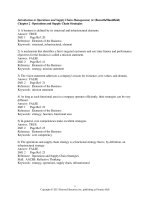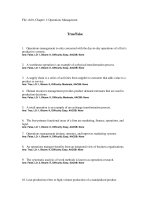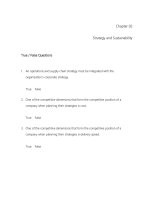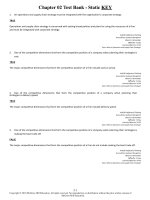Introduction to operations and supply chain management 3e bozarth chapter 13
Bạn đang xem bản rút gọn của tài liệu. Xem và tải ngay bản đầy đủ của tài liệu tại đây (736.44 KB, 31 trang )
JIT/Lean Production
Chapter 13
Chapter Objectives
Be able to:
Describe JIT/Lean and differentiate between the Lean philosophy and kanban
systems.
Discuss the Lean perspective on waste and describe the eight major forms of
waste, or muda, in an organization.
Discuss the Lean perspective on inventory and describe how a kanban system
helps control inventory levels and synchronize the flow of goods and material
across a supply chain.
Describe how the concepts of the Lean supply chain and Lean Six Sigma
represent natural extensions of the Lean philosophy.
Explain how a two-card kanban system works.
Calculate the number of kanban cards needed in a simple production
environment.
Show how MRP and kanban can be linked together and illustrate the process
using a numerical example.
Copyright © 2013 Pearson Education, Inc. publishing as Prentice Hall
13 - 2
Just-in time/Lean
Just-in-time – A philosophy of manufacturing,
applicable to manufacturing and services based on
planned elimination of all waste and on continuous
improvement of productivity
Lean – A philosophy of production that emphasizes
the minimization of the amount of all resources
(including time) used in the various activities of an
enterprise. It includes identifying and eliminating
non-value-adding activities. © 2010 APICS Dictionary
Copyright © 2013 Pearson Education, Inc. publishing as Prentice Hall
13 - 3
Performance Advantage
of a Lean Plant Circa 1986
Figure 13.1
Kicked off the JIT/Lean Production Revolution
in the late 1980’s/early 1990’s
Copyright © 2013 Pearson Education, Inc. publishing as Prentice Hall
13 - 4
Lean Philosophy
The Lean philosophy can be applied to a wide range
of production and service environments.
Companies following the Lean philosophy can and
do use a wide range of planning and control
techniques, not just kanban.
The Lean philosophy is consistent with business
process improvement, quality improvement, and
supplier management initiatives.
Copyright © 2013 Pearson Education, Inc. publishing as Prentice Hall
13 - 5
Lean Waste
Lean Waste – Any activity that does not add value to the good or service
in the eyes of the consumer.
Called “muda” in Japanese
© 2010 APICS Dictionary
Identification of lean wastes began with Taiichi
Ohno, a Toyota engineer.
Copyright © 2013 Pearson Education, Inc. publishing as Prentice Hall
13 - 6
Eight Lean Wastes
Overproduction
Waiting
Unnecessary transportation
Inappropriate process
Unnecessary inventory
Unnecessary/excess motion
Defects
Underutilization of employees
Copyright © 2013 Pearson Education, Inc. publishing as Prentice Hall
13 - 7
Lean Perspective on Inventory
Triangles represent inventory between work centers A, B,
and C.
The buildup of inventory hides problems (at a cost) that may
occur.
Figure 13.2
Copyright © 2013 Pearson Education, Inc. publishing as Prentice Hall
13 - 8
Lean Perspective on Inventory
After a Lean transformation, wasted movement and space
are eliminated and work centers are moved closer together.
Inventory levels are reduced dramatically and work centers
make only what is needed when it is needed.
Figure 13.3
Copyright © 2013 Pearson Education, Inc. publishing as Prentice Hall
13 - 9
Lean Perspective on Inventory
Process of reducing inventory leads to reduction
of the other “wastes” and exposes problems in
order of severity (‘water and rocks’ analogy)
Figure 13.4
Copyright © 2013 Pearson Education, Inc. publishing as Prentice Hall
13 - 10
Recent Developments
in Lean Thinking
Lean Six Sigma – A methodology that combines the
organizational elements and tools of Six Sigma with
Lean’s focus on waste reduction.
Lean Supply Chain Management – An extension of
the Lean philosophy to supply chain efforts beyond
production. Lean supply chain management seeks
to minimize the level of resources required to carry
out all the supply chain activities.
Copyright © 2013 Pearson Education, Inc. publishing as Prentice Hall
13 - 11
Kanban System
Kanban system – A production control approach that uses
containers, cards, or visual cues to control the production
and movement of goods through the supply chain.
Key characteristics:
Uses simple signaling mechanisms to indicate when specific items
should be produced or moved.
Can be used to synchronize activities either within a plant or between
different supply chain partners.
Are not considered planning tools, but rather control mechanisms that
are designed to pull parts or goods through the supply chain based on
downstream demand.
Copyright © 2013 Pearson Education, Inc. publishing as Prentice Hall
13 - 12
Kanban System
Two-card kanban system – Uses one card to control production and
another card to control movement of materials.
Copyright © 2013 Pearson Education, Inc. publishing as Prentice Hall
13 - 13
Kanban System for
Two Work Centers
Figure 13.5
Copyright © 2013 Pearson Education, Inc. publishing as Prentice Hall
13 - 14
Release of Finished Materials
from Work Center B
Figure 13.6
Copyright © 2013 Pearson Education, Inc. publishing as Prentice Hall
13 - 15
Pulling of Raw Materials into
Production at Work Center B
Figure 13.7
Copyright © 2013 Pearson Education, Inc. publishing as Prentice Hall
13 - 16
Removal of Finished Materials
from Work Center A
Figure 13.8
Copyright © 2013 Pearson Education, Inc. publishing as Prentice Hall
13 - 17
Two-card System Summary
A downstream system station pulls finished material out of work center
B.
Work center B pulls raw material into production.
Demand for more raw material in work center B pulls finished material
out of work center A.
Copyright © 2013 Pearson Education, Inc. publishing as Prentice Hall
13 - 18
Pull System
Pull system – A production system in which actual downstream demand
sets off a chain of events that pulls material through the various process
steps.
A kanban system is also called a pull system.
Copyright © 2013 Pearson Education, Inc. publishing as Prentice Hall
13 - 19
Kanban System
Other signaling methods:
Single-card systems
Color coding of containers
Designated storage spaces
Computerized bar-coding systems
Copyright © 2013 Pearson Education, Inc. publishing as Prentice Hall
13 - 20
Controlling Inventory
Levels Using Kanbans
Calculating the number of kanbans:
Copyright © 2013 Pearson Education, Inc. publishing as Prentice Hall
13 - 21
Kanban - Example 13.2
Determine the number of production cards needed using the following
information:
Copyright © 2013 Pearson Education, Inc. publishing as Prentice Hall
13 - 22
Kanban - Example 13.2
Convert the number of kanbans into the number of
subassemblies and hours work:
Copyright © 2013 Pearson Education, Inc. publishing as Prentice Hall
13 - 23
Kanban - Example 13.3
After a Lean initiative, the following improvements, were made:
Production lead time has been cut from 2.6 hours
to a constant 1.6 hours.
Demand from final assembly has been stabilized
at 300 subassemblies per hour.
Smaller, standardized containers that hold just 25
subassemblies are now being used.
Copyright © 2013 Pearson Education, Inc. publishing as Prentice Hall
13 - 24
Kanban - Example 13.3
If the safety factor is reduced to 4%
Copyright © 2013 Pearson Education, Inc. publishing as Prentice Hall
13 - 25









